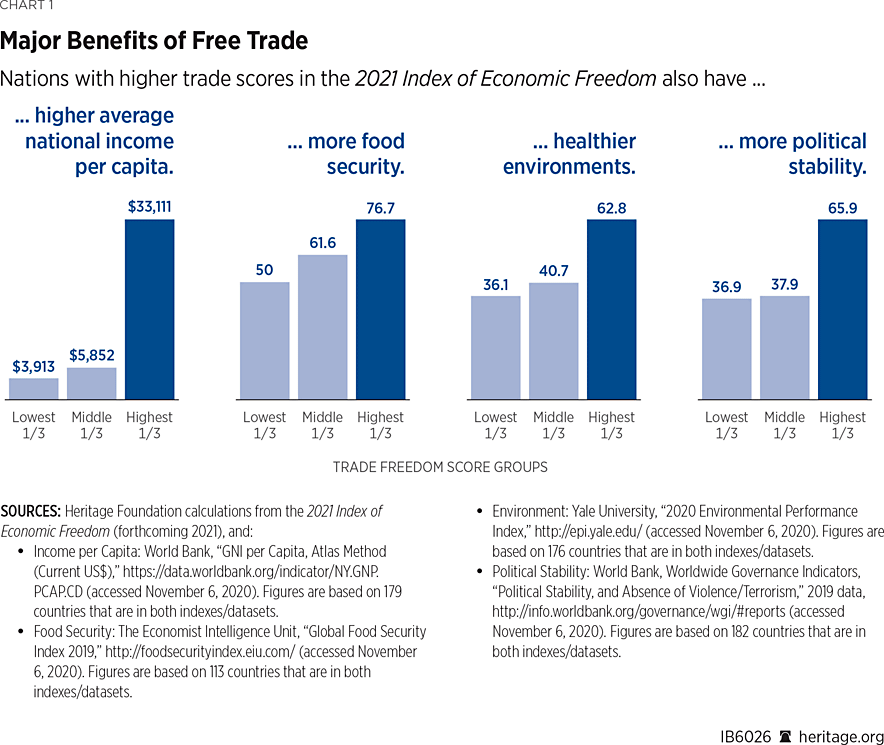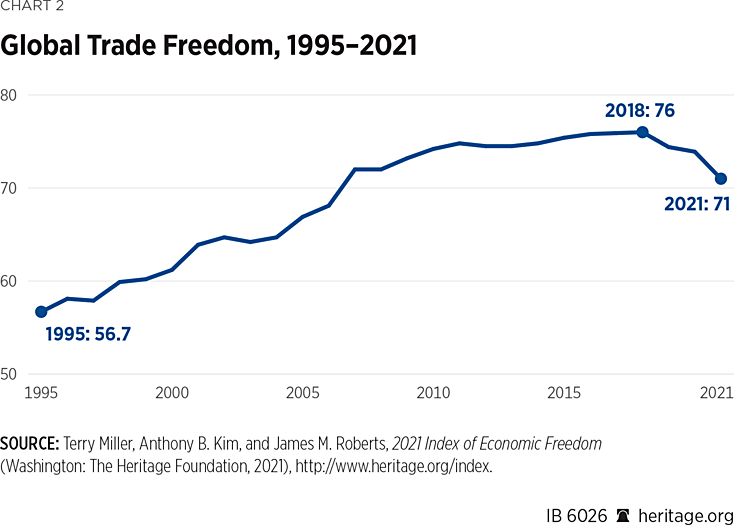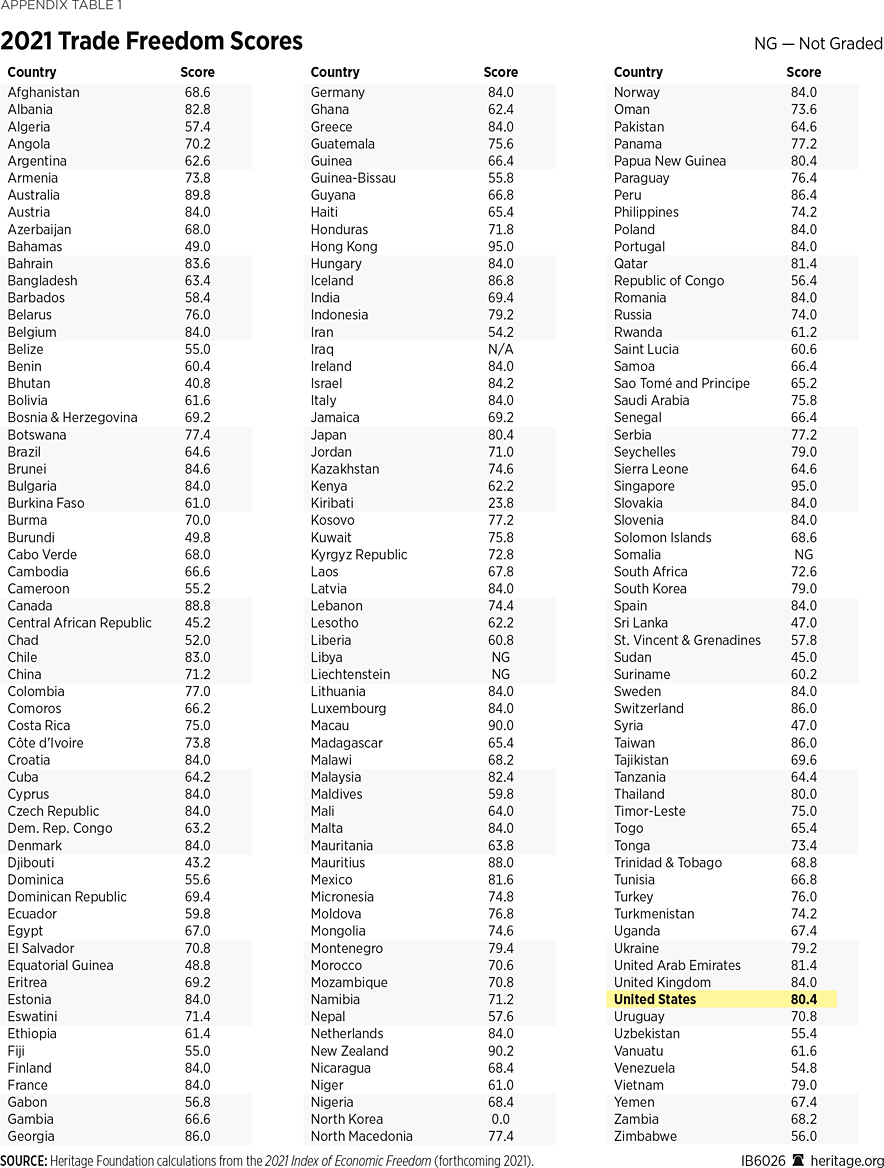Global trade freedom has fallen for the third straight year and is at its lowest level since 2006. For countries around the world, that means higher tariffs and nontariff barriers than in the past. For families and businesses, it means that trading is more difficult and costly. The downward trend in trade freedom started well before the coronavirus pandemic, but a worldwide combination of pandemic-related business shutdowns and economic struggles has caused global goods trade to contract.
Initially, many countries responded to the pandemic and increased demand for medical goods—such as face masks and ventilators—with trade measures that restricted the free movement of those products. While many of those measures were eventually removed, they undoubtedly made it more difficult for products to go where they were most needed. Economic recovery discussions in the U.S. and around the world are now focusing on how to prevent such a recession in the future.
While countries may be tempted to close themselves off to the world and international supply chains, doing so will make it more difficult and more costly for their citizens to get what they need. The Heritage Foundation’s Index of Economic Freedom has demonstrated for more than 25 years that economic openness yields better results for individuals around the world. The same is true for countries that reduce barriers to trade and allow individuals to exchange freely with the world. Policymakers around the world should work to eliminate barriers to trade as economies recover from the pandemic.
Basics of Trade Freedom
Trade freedom measures the degree to which individuals within an economy can buy from and sell to people around the world free from government intervention. Barriers to trade freedom include tariffs (taxes on imports) as well as nontariff barriers. Nontariff barriers are more elusive and can range from quotas to trade-distorting subsidies and regulations. Governments implement trade barriers to manage the flow of imports and exports and to insulate domestic producers from foreign competition. However, the lines of domestic and foreign-made products are increasingly blurred because of the rapid growth of international supply chains as well as the shift to services and digital trade.
For more than 25 years, the Index of Economic Freedom has shown a strong correlation between high levels of overall trade freedom and greater prosperity for individuals within an economy.REF As shown in Chart 1, countries with greater trade freedom have higher—and often much higher—income per capita. The individuals within these countries also enjoy greater food security, healthier environments, and increased political stability.

This is because eliminating trade barriers that would otherwise give local producers a competitive edge requires those producers to compete to offer the best product at the best price. This competition fosters innovation and allows consumers to access goods and services at market prices. It also puts the freedom of individuals at the forefront by allowing families and businesses to make choices based on their needs.
Trade Freedom Trends
For years, trade freedom was on the rise worldwide, but now, for the first time, global trade freedom has dropped for three consecutive years. After peaking in 2018 at 76, trade freedom dropped to its lowest level since 2006 in the 2021 Index. For countries around the world, that means higher tariffs and nontariff barriers than in the past. As a result, trade has become more difficult and more costly for individuals and businesses alike.

For example, the average tariff rate in the U.S. nearly doubled between 2018 and 2020 because of new tariffs on nearly all imports from China and alleged national security tariffs on steel and aluminum.REF China, the European Union, and several other countries have responded by implementing retaliatory tariffs.REF Countries such as France and the United Kingdom are advancing digital services taxes and other nontariff barriers to e-commerce.REF At the same time, barriers to agriculture trade and agricultural subsidies remain high in both developed and developing countries.
Threats to Advancing Trade Freedom
Before the coronavirus pandemic, protectionism was on the rise. In October 2019, the World Trade Organization (WTO) estimated that global goods trade would increase by only 1.2 percent in 2019. The WTO’s Director-General at the time, Roberto Azevedo, said that “the darkening outlook for trade is discouraging but not unexpected. Beyond their direct effects, trade conflicts heighten uncertainty, which is leading some businesses to delay the productivity-enhancing investments that are essential to raising living standards.”REF
In some countries, such as the U.S., the rise of protectionism can be attributed largely to the Trump Administration’s tariffs and trade war with China. In recent years, the European Union has often focused on “sustainable trade” and regulatory harmonization with its trading partners, which leads to more restrictive nontariff barriers.REF And while China seemed to be embracing capitalism early in the 21st century, the Chinese Communist Party’s economic system exists to maintain control, not to increase freedom and prosperity for its people.REF
Put simply, the world lacks a free trade leader. These countries should look to the success of economies like Hong Kong, Singapore, New Zealand, and Macau, all of which received trade freedom scores above 90. Unsurprisingly, these economies are also some of the world’s most prosperous.
Conclusion
Each year, the Index of Economic Freedom shows that economies and people are better off when trade remains free and open. The correlations are undeniable. To improve their trade freedom scores, countries should first and foremost seek to lower their domestic barriers to trade by eliminating tariffs and nontariff barriers. The simplest way to do this is unilateral tariff elimination, but entering into free trade agreements with other countries can also lower barriers. It is crucial, however, that these agreements truly promote free trade rather than manage trade flows through burdensome regulations. Countries must also remain dedicated to their WTO commitments while seeking to reform the organization.
Tori K. Smith is Jay Van Andel Trade Economist in the Thomas A. Roe Institute for Economic Policy Studies, of the Institute for Economic Freedom, at The Heritage Foundation. Patrick Tyrrell, Research Coordinator in the Center for International Trade and Economics, of the Kathryn and Shelby Cullom Davis Institute for National Security and Foreign Policy, at The Heritage Foundation, made valuable contributions to this Issue Brief.

Appendix B
Methodology
Trade freedom is a composite measure of the extent of tariff and nontariff barriers that affect imports and exports of goods and services. The trade freedom score is based on two inputs:
- The trade-weighted average tariff rate and
- A qualitative evaluation of nontariff barriers (NTBs).
Different imports entering a country can (and often do) face different tariffs. The weighted average tariff uses weights for each tariff based on the share of imports for each good. Weighted average tariffs are a purely quantitative measure and account for the calculation of the base trade freedom score using the following equation:
Trade Freedomi = 100(Tariffmax–Tariffi)/(Tariffmax–Tariffmin) – NTBi
where Trade Freedomi represents the trade freedom in country i; Tariffmax and Tariffmin represent the upper and lower bounds for tariff rates (%); and Tariffi represents the weighted average tariff rate (%) in country i. The minimum tariff is naturally zero percent, and the upper bound was set at 50 percent.
We determine the extent of NTBs in a country’s trade policy regime using both qualitative and quantitative information. Restrictive rules that hinder trade vary widely, and their overlapping and shifting nature makes their complexity difficult to gauge. The types of NTBs considered in our scoring include:
- Quantity restrictions—import quotas; export limitations; voluntary export restraints; import–export embargoes and bans; countertrade; etc.
- Regulatory restrictions—licensing; domestic content and mixing requirements; sanitary and phytosanitary standards (SPSs); safety and industrial standards regulations; packaging, labeling, and trademark regulations; advertising and media regulations.
- Customs restrictions—advance deposit requirements; customs valuation procedures; customs classification procedures; customs clearance procedures.
- Direct government intervention—subsidies and other aid; government industrial policies; government-financed research and other technology policies; competition policies; government procurement policies; state trading, government monopolies, and exclusive franchises.
In addition, where possible, we consider and report the number of nontariff measures in force as calculated by the World Trade Organization (WTO).
As an example, Togo received a trade freedom score of 65.4. By itself, Togo’s trade-weighted average tariff of 12.3 percent would have yielded a score of 75.4, but the evaluation of NTBs in Togo resulted in a 10-point deduction from that score.
Gathering tariff statistics to make a consistent cross-country comparison is a challenging task. Unlike data on inflation, for instance, some countries do not report their weighted average tariff rate or simple average tariff rate every year.
To preserve consistency in grading the trade freedom component, the Index uses the most recently reported most favored nation (MFN) trade-weighted average tariff rate for a country from our primary source.
The most comprehensive and consistent information on MFN trade-weighted average tariff rates is published by the WTO. When the MFN trade-weighted average applied tariff rate is not available, the Index uses the country’s simple average of MFN tariff rates; when the country’s simple average MFN tariff rate is not available, the weighted average or the simple average of applied tariff rates is used. In the very few cases where tariff rates are not available from the WTO or the World Bank, data on international trade taxes or an estimated effective tariff rate are used instead.
The Index relies on the following sources in determining scores for trade policy, in order of priority: World Trade Organization, World Tariff Profiles; World Bank, World Development Indicators; World Trade Organization, Trade Policy Review; Office of the U.S. Trade Representative, National Trade Estimate Report on Foreign Trade Barriers; World Bank, Doing Business; U.S. Department of Commerce, Country Commercial Guide; Economist Intelligence Unit, Country Commerce; and official government publications of each country.


